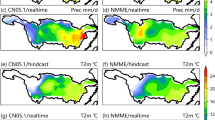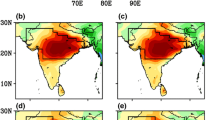Abstract
In coupled general circulation models, which are widely used to study weather and climate in subseasonal-to-seasonal timescales, forecast errors pertaining to the systematic model biases could occur. These errors can be overcome using initialization processes, but imperfections in these processes often lead to initialization shock. To investigate this issue, this study examines the impact of imbalanced ocean initial conditions (ICs) on seasonal prediction skills via an atmosphere–land–ocean–sea ice-coupled forecasting system. Three types of ensemble experiments were conducted from 1980 to 2016: (1) the noDA experiment with no data assimilation but with dynamic balance among oceanic variables through the ocean component model (MOM3); (2) the DA_IB experiment with data assimilation but with the dynamic imbalance between assimilated and non-assimilated variables in the IC; (3) the DA_B experiment with data assimilation and balanced states among the ICs. The results show that the prediction skill of DA_B is noticeably higher over most of the globe than the others in winter forecasts, particularly in the middle-high latitudes for ocean, sea ice, and atmospheric variables. The inferior performance of DA_IB compared to noDA at high latitudes, including the Arctic, indicates that the initialization shock caused by spatial discontinuity and dynamic imbalance among variables can cause low prediction skill. We present quantitative evidence via numerical experiments to indicate the negative impact of imbalanced oceanic ICs on other component systems, consequently limiting the seasonal prediction skills. The results of this study will contribute to the understanding of the shock effects on sub-seasonal- to seasonal-scale forecasts.










Similar content being viewed by others
References
Ahn JB, Lee JA (2001) Numerical study on the role of sea-ice using ocean gerneral cirulation model. J Kor Soc Ocea 6(4):225–233 (in Korean with English abstract)
Ahn JB, Lee J (2016) A new multi-model ensemble method using nonlinear genetic algorithm: an application to boreal winter surface air temperature and precipitation prediction. J Geophys Res 121(16):9263–9277
Ahn JB, Yoon YH, Cho EH, Oh HR (2005) A study of global ocean data assimilation using VAF. J Kor Soc Ocea 10(1):69–78
Ahn JB, Lee JL, Im ES (2012a) The reproducibility of surface air temperature over South Korea using dynamical downscaling and statistical correction. J Meteorol Soc Jpn 90(4):493–507
Ahn JB, Lee SB, Ryoo SB (2012b) Development of 12-month ensemble prediction system using PNU CGCM V11. Atm Kor Meteorol Soc 22(4):455–464
Alves O, Balmaseda MA, Anderson D, Stockdale T (2004) Sensitivity of dynamical seasonal forecasts to ocean initial conditions. Q J R Meteorol Soc 130:647–667
Balmaseda MA, Anderson D (2009) Impact of initialization strategies and observations on seasonal forecast skill. Geophys Res Lett 36:L01701. https://doi.org/10.1029/2008GL035561
Balmaseda MA, Vidard A, Anderson DL (2008) The ECMWF ocean analysis system: ORA-S3. Mon Wea Rev 136(8):3018–3034
Balmaseda MA et al (2009) Ocean initialization for seasonal forecasts. Oceanography 22:154–159
Balmaseda MA et al (2010) Initialization for seasonal and decadal forecasts. In: Ocean Obs 09, European Space Agency, pp 19–26
Balmaseda MA, Mogensen K, Weaver AT (2013) Evaluation of the ECMWF ocean reanalysis system ORAS4. Q J R Meteorol Soc 139(674):1132–1161
Behringer DW, Ji M, Leetmaa A (1998) An improved coupled model for ENSO prediction and implications for ocean initialization. Part I: the ocean data assimilation system. Mon Wea Rev 126:1013–1021
Blackport R, Screen JA, van der Wiel K, Bintanja R (2019) Minimal influence of reduced Arctic sea ice on coincident cold winters in mid-latitudes. Nat Clim Change 9(9):697–704
Blankenship C, Case J, Zavodsky B, Jedlovec G (2014) Assimilation of SMOS retrieved soil moisture into the land information system. In EUMETSAT Conf. 2014, Geneva, Switzerland, EUMETSAT, 8 pp. Available online at http://ntrs.nasa.gov/archive/nasa/casi.ntrs.nasa.gov/20150001376.pdf
Branković Č, Palmer TN, Molteni F, Tibaldi S, Cubasch U (1990) Extended-range predictions with ECMWF models: time-lagged ensemble forecasting. Q J R Meteorol Soc 116(494):867–912
Browne PA, de Rosnay P, Zuo H, Bennett A, Dawson A (2019) Weakly coupled ocean–atmosphere data assimilation in the ECMWF NWP system. Remote Sens 11(3):234
Charney JG (1951) Dynamic forecasting by numerical process. In: Compendium of meteorology. American Meteorological Society, pp 470–482
Chen M, Wang W, Kumar A (2010) Prediction of monthly-mean temperature: the roles of atmospheric and land initial conditions and sea surface temperature. J Clim 23(3):717–725
Day JJ, Hawkins E, Tietsche S (2014) Will Arctic sea ice thickness initialization improve seasonal forecast skill? Geophys Res Lett 41(21):7566–7575
Derome J, Lin H, Brunet G (2005) Seasonal forecasting with a simple general circulation model: Predictive skill in the AO and PNA. J Clim 15:597–609
Helgert S, Khodayar S (2020) Improvement of the soil-atmosphere interactions and subsequent heavy precipitation modelling by enhanced initialization using remotely sensed 1 km soil moisture information. Remote Sens Environ 246:111812
Huang XY (2000) Variational analysis using spatial filters. Mon Wea Rev 128:2588–2600
Hurrel J, Hack JJ, Boville BA, Williamson D, Kiehl JT (1998) The dynamical simulation of the NCAR community climate model version 3 (CCM3). J Clim 11:1207–1236
IPCC (2007) Climate change 2007-the physical science basis. In: Solomon S, Qin D, Manning M, Chen Z, Marquis M, Averyt KB, Tignor M, Miller HL (eds) Contribution of working group I to the fourth assessment report of the intergovernmental panel on climate change. Cambridge University Press, Cambridge, United Kingdom and New York, NY, USA, pp 634, 647, 793–795.
Jaiser R, Dethloff K, Handorf D, Rinke A, Cohen J (2012) Impact of sea ice cover changes on the Northern Hemisphere atmospheric winter circulation. Tellus a: Dyn Meteorol Oceanogr 64(1):11595
Jo S, Ahn JB (2014) Improvement of CGCM prediction for wet season precipitation over Maritime Continent using a bias correction method. Int J Climatol 35(13):3721–3732
Kanamitsu M, Ebisuzaki W, Woollen J, Yang SK, Hnilo JJ, Fiorino M, Potter GL (2002) NCEP-DEO AMIP-II reanalysis (R-2). Bull Amer Meteorol Soc 83:1631–1643
Kharin VV, Zwiers FW, Gagnon N (2001) Skill of seasonal hindcasts as a function of the ensemble size. Clim Dyn 17:835–843
Kiehl JT, Hack JJ, Bonan GB, Boville BA, Briegleb BP, Williamson DL, Rasch PJ (1996) Description of the NCAR Community Climate Model (CCM3). NCAR Tech. Note. NCAR/TN-420+STR, 152 pp
Kim HJ, Ahn JB (2015) Improvement in prediction of the arctic oscillation with a realistic ocean initial condition in a CGCM. J Clim 28(22):8951–8967
Kim HM, Webster PJ, Curry JA (2012) Seasonal prediction skill of ECMWF System 4 and NCEP CFSv2 retrospective forecast for the Northern Hemisphere Winter. Clim Dyn 39(12):2957–2973
Kim BM et al (2014) Weakening of the stratospheric polar vortex by Arctic sea-ice loss. Nat Commun 5(1):1–8
King RR, Lea DJ, Martin MJ, Mirouze I, Heming J (2020) The impact of Argo observations in a global weakly coupled ocean–atmosphere data assimilation and short-range prediction system. Q J R Meteorol Soc 146(726):401–414
Kolassa J et al (2017) Data assimilation to extract soil moisture information from SMAP observations. Remote Sens 9(11):1179
Kug JS, Kang IS, Choi DH (2008) Seasonal climate predictability with tier-one and tier-two prediction system. Clim Dyn 31:403–416
Kug JS, Jeong JH, Jang YS, Kim BM, Folland CK, Min SK, Son SW (2015) Two distinct influences of Arctic warming on cold winters over North America and East Asia. Nat Geosci 8(10):759–762
Lee JL, Ahn JB (2015) Comparative study on the seasonal predictability dependency of boreal winter 2m temperature and sea surface temperature on CGCM initial conditions. Atm Kor Meteorol Soc 25(2):353–366 (in Korean with English abstract)
Lorenz EN (1963) Deterministic nonperiodic flow. J Atmos Sci 20:130–148
Min YM, Kryjov VN, Oh SM (2014) Assessment of APCC multimodel ensemble prediction in seasonal climate forecasting: Retrospective (1983–2003) and real-time forecasts (2008–2013). J Geophys Res 119:12132–12150
Molteni F, Stockdale T, Balmaseda MA, Balsamo G, Buizza R, Ferranti L, Magnusson L, Mogensen K, Palmer T, Vitart F (2011) The new ECMWF seasonal forecast system (System 4). ECMWF Technical Memorandum 656
Mori M, Watanabe M, Shiogama H, Inoue J, Kimoto M (2014) Robust Arctic sea-ice influence on the frequent Eurasian cold winters in past decades. Nat Geosci 7(12):869–873
Mulholland DP, Laloyaux P, Haines K, Balmaseda MA (2015) Origin and impact of initialization shocks in coupled atmosphere–ocean forecasts. Mon Wea Rev 143(11):4631–4644
Pacanowski RC, Griffies SM (1998) MOM 3.0 Manual. NOAA/Geophysical Fluid Dynamics Laboratory, Princeton
Palmer T et al (2004) Development of a European multimodel ensemble system for seasonal-to-interannual prediction (DEME-TER). Bull Amer Meteorol Soc 85:853–872
Polkova I, Köhl A, Stammer D (2014) Impact of initialization procedures on the predictive skill of a coupled ocean–atmosphere model. Clim Dyn 42(11–12):3151–3169
Saha S et al (2006) The NCEP climate forecast system. J Clim 19:3483–3517
Saha S et al (2014) The NCEP climate forecast system version 2. J Clim 27(6):2185–2208
Seneviratne SI et al (2010) Investigating soil moisture–climate interactions in a changing climate: a review. Earth Sci Rev 99(3–4):125–161
Shukla RP, Huang B, Marx L, Kinter JL, Shin CS (2018) Predictability and prediction of Indian summer monsoon by CFSv2: implication of the initial shock effect. Clim Dyn 50(1–2):159–178
Stammer D, Balmaseda M, Heimbach P, Köhl A, Weaver A (2016) Ocean data assimilation in support of climate applications: status and perspectives. Ann Rev Mar Sci 8:491–518
Stensrud DJ, Brooks HE, Dun J, Tracton MS, Rogers E (1999) Using ensembles for short-range forecasting. Mon Wea Rev 127(4):433–446
Sun JQ, Ahn JB (2011) A GCM-based forecasting model for the landfall of tropical cyclones in China. Adv Atmos Sci 28:1049–1055
Sun JQ, Ahn JB (2015) Dynamical seasonal predictability of the arctic oscillation using a CGCM. Int J Climatol 35(7):1342–1353
Titchner HA, Rayner NA (2014) The Met Office Hadley Centre sea ice and sea surface temperature data set, version 2: 1 Sea Ice Concentrations. J Geophys Res 119(6):2864–2889
Wang G, Kleeman R, Smith N, Tseitkin F (2002) The BMRC coupled general circulation model ENSO forecast system. Mon Wea Rev 130:975–991
Wang C, Zhang L, Lee S-K, Wu L, Mechoso CR (2014) A global perspective on CMIP5 climate model biases. Nat Clim Change 4:201–205. https://doi.org/10.1038/nclimate2118
Yang F, Pan HL, Krueger SK, Moorthi S, Lord SJ (2006) Evaluation of the NCEP Global Forecast System at the ARM SGP site. Mon Wea Rev 134(12):3668–3690
Zhao M, Hendon HH, Alves O, Yin Y (2014) Impact of improved assimilation of temperature and salinity for coupled model seasonal forecasts. Clim Dyn 42(9–10):2565–2583
Acknowledgements
This work was funded by the Korea Meteorological Administration Research and Development Program under Grant KMI2021-01211.
Author information
Authors and Affiliations
Corresponding author
Additional information
Publisher's Note
Springer Nature remains neutral with regard to jurisdictional claims in published maps and institutional affiliations.
Supplementary Information
Below is the link to the electronic supplementary material.
Rights and permissions
About this article
Cite this article
Lee, J., Lee, MI. & Ahn, JB. Importance of ocean initial conditions of late autumn on winter seasonal prediction skill in atmosphere–land–ocean–sea ice coupled forecast system. Clim Dyn 58, 3427–3440 (2022). https://doi.org/10.1007/s00382-021-06106-y
Received:
Accepted:
Published:
Issue Date:
DOI: https://doi.org/10.1007/s00382-021-06106-y




